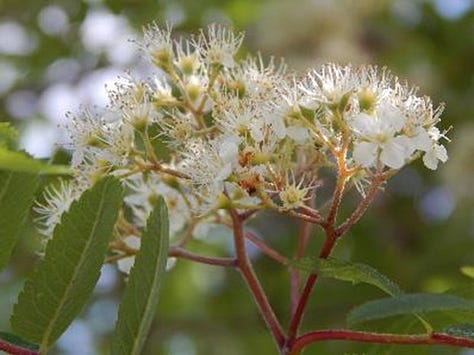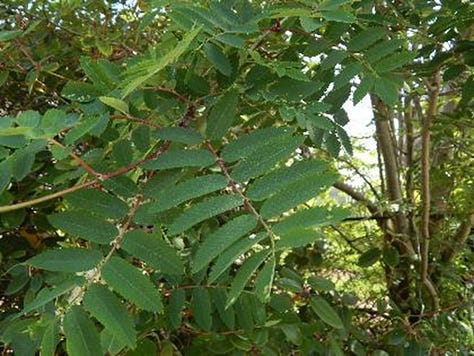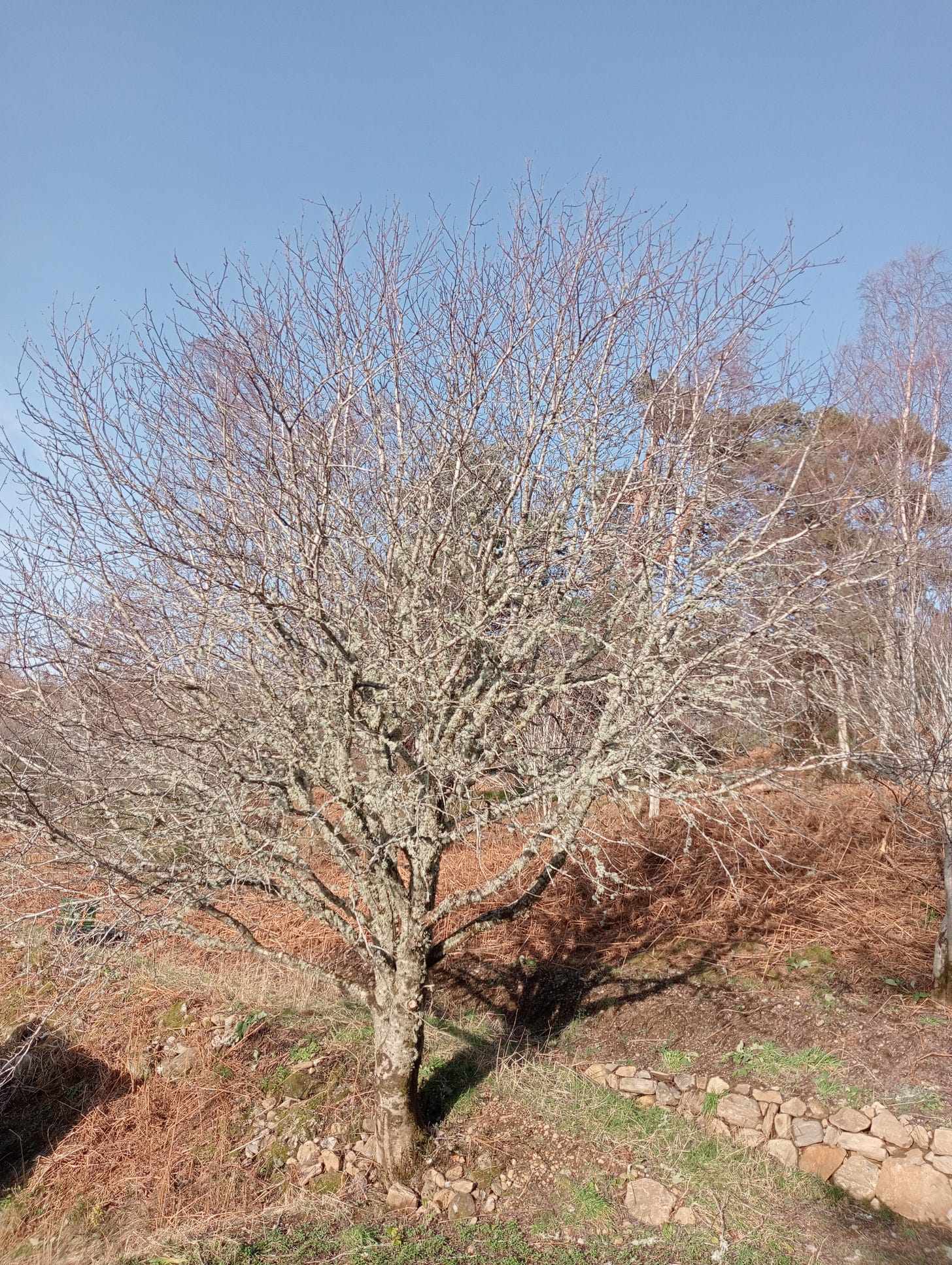The Resilient Rowan or Mountain Ash
Michelle Melville takes a look at this symbol of protection in folklore
Here in the highlands of Scotland, so often battered by storms - such as last week’s bout of wind and occassional lashing sleet - we find the Rowan tree, also known as the mountain ash (Sorbus aucuparia), standing as a symbol of resilience. This slender sentinel of the natural world, often finds its home on rocky outcrops, cliff edges, and within the embrace of gullies. It’s roots, dug into the sparse soil, seem able to tough it out in even the worst of the winter storms.
Then every year this sacred tree heralds the spring, producing copious clusters of creamy white flowers, perched on top of it’s easily recognisable pinnate green leaves. Months later it announces the arrival of autumn with vibrant red berries.



Throughout the seasons its canopy provides a sheltered habitat to birds amongst its branches, who in returning the favour, sow Rowan seeds far and wide. The ecological importance of the Rowan is profound in the frozen north. It’s berries, bright beacons in the winter landscape, offer much needed sustainance to a multitude of creatures when other food sources are scarce.
Folklore
In the mystical traditions of Scandinavia, the Rowan trees that sprouted from rocks, known as 'flying rowan', were believed to possess a powerful magic.
In Norse mythology, the Rowan's significance is even more profound. Said to have given life to the first woman, the Rowan underscores its association with life and vitality, mirroring the creation of the first man from an Ash tree. A Rowan tree once saved the Norse god Thor, bending itself over a fast-flowing river to help him return to shore, a story that echoes in the Rowan trees bending over our own mountain burns to this day.
In Scotland, Rowan was often planted near homes and in graveyards, it was (and still is) thought to be a shield against witches, evil spirits, and the elusive fairies. The Rowan's presence is believed to offer a protective charm, of safety and sanctuary. The Rowan's berries, each marked with a tiny five-pointed star opposite its stalk, were symbols of life-blood. Strung onto red thread, they were worn as protection from the unseen world beyond.
Around Bealtane, animals were led through circles made of Rowan boughs, and the boughs themselves, often bound with red thread to increase their protective power, were placed above byre doors and entwined into the tails of cattle. These boughs, symbols of enduring protection, were renewed each Bealtane in a timeless ritual.
In the Highlands, it is considered ill-fated to cut down a Rowan or to sever its branches with iron (a knife), except on occasions when creating implements for ritual purposes.
To protect against evil, particularly for children, Rowan sticks, again tied with red thread, were worn or sewn into the lining of clothes. In the form of an equal-armed cross, these talismans were believed to offer powerful protection. Across doorways and windows, Rowan crosses were placed to prevent the entry of evil. In the perilous time before a child's baptism, when they were considered most vulnerable to the ‘evil-eye’, witchcraft or fairy abduction, a Rowan cross was fixed to the cradle or clothing.
The red thread, the colour of blood, was believed to possess strong magical properties, as captured in the saying:
‘Rowan tree and red thread, make the witches lose their speed.’
The Rowan tree's magic also weaves through Scottish poetry and song, enchanting all who hear of it. It stands as a symbol of the beauty and mystery of the Scottish landscape, its ability to thrive in the most unlikely places a metaphor for the enduring spirit of the Scottish people.
Practically, the Rowan tree was an essential resource in the Highlands. Its strong and resilient wood was used for tool handles and walking sticks, while its bark and roots found use in traditional medicine (believed to treat ailments from diarrhea) and as dyes for wool.
More than just a part of the natural Scottish landscape, the Rowan tree is actually a cultural cornerstone, embodying the essence of the region's identity. The folklore surrounding the Rowan tree permeates through Scottish poetry and song, with numerous references to its enchanting nature and its power to enchant, such as in Robert Burn’s contemporary, Carolina Oliphant, Lady Nairne’s song Rowan tree: :
‘Oh Rowan tree, oh rowan tree,
Thou’lt be dear to thee,
Entwined thou art wi’ many ties,
o’ hame and infancy’

And even today, the Rowan tree still holds a place in the hearts of Highlanders. It's not uncommon to see a Rowan tree planted by a gate or a doorway, continuing the old tradition of protection.
In modern times, this tradition has been complemented by conservation efforts to protect and preserve native woodland species, including the Rowan, ensuring that it remains a fundamental part of the Highland ecosystem. In the face of these current harsh and windy conditions, the Rowan tree certainly endures, a living symbol of resilience and survival.
Michelle Melville is High Life Highland’s Heritage Ranger, is passionately dedicated to preserving Scottish natural and cultural heritage, through her commitment to mastering and teaching traditional Scottish Highland crafts. A skilled artisan, Michelle excels in a range of hand crafts from carving and weaving to stained glass creation and needle felting. Her talent in these crafts is not just a personal pursuit but a vital part of her role in engaging and inspiring communities. Michelle's deep connection with Gaelic culture and folklore enriches her engagement work, whilst initiatives, such as the celebrated ‘Lochaber Story Quilt’ are a testament to her dedication in promoting Scotland's rich cultural history, and preserving traditional crafting skills for years to come.
Love trees? Keep scrolling…..
________________________________________________________________________











